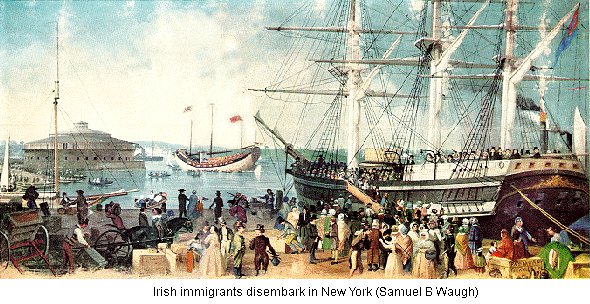Journal Volume 5 2006
Surplus People from Newcastle and Ballyvolan (continued/9)
Ashore
Perhaps it was in the Quarantine Stations in American and Canadian ports that the courage of priests, ministers and nuns was at its most admirable. In the words of emigration historian Terry Coleman:
‘Wherever destitute Irish emigrants were gathered, Liverpool, New York, Boston, Quebec, priests were there among them to administer to their needs. Many of these priests came into contact with contagious diseases and died.’25

Roman Catholic and Anglican priests could be found in the fever tents on perhaps the most notorious Quarantine Station of all – Grosse Ile, the gateway, or in many cases the barrier, to Quebec. The niceties of theology were set aside in this time of crisis. Two Anglican and four Roman Catholic priests died there, as did several of the Grey Nuns. The situation at Montreal was not much better. There, the Catholic bishop Power went to give a dying woman the last rites. Her sense of consolation at having been anointed was evident to all, and satisfied that her soul was saved she died calmly. Power showed symptoms of the disease the next day and died soon afterwards. Such devotion to duty prompted the following editorial of the Boston newspaper, The Pilot, in July 1847:
‘There never surely was any Church which proved, at the sacrifice of comfort and life, its devotion to religion, than does now the Roman Catholic clergy of Montreal.’
What a pity the writer failed to recognise the rare brand of trans-sectarian Christianity which was displayed by all concerned in those make-shift hospitals.
Conclusion
By any yardstick, the clearance programme carried out on the Coolattin estate between 1847 and 1856 was a massive undertaking - and a costly one. William Graves charged the estate £3-8-6 for each tenant shipped, but this was not the total cost per head by any means. As can be seen from the general ledgers, the estate provided oatmeal and rice to supplement the emigrants' diet during the voyage. The sea chests were paid for by the estate, as was the carriage of people and luggage from the estate to New Ross. There was also the very large cost of enticing people to surrender theirholdings. All-in-all, between 1848 and 1856, the programme cost Fitzwilliam £16,342-11-1. I have yet to find the costs incurred in 1847, but more than one-third of the entire emigrant number left the estate in that first year so the likely cost would have been about £8,000, making a grand total of approximately £24,000. A massive amount at the time, but a wise investment in the long-term. The ‘Surplus People’ had been disposed of and the structure of the estate altered irrevocably.
The clearances achieved the desired effect. Between 1847 and 1856, the tenant population on the estate was reduced from 20,000 to 14,000. This was further reduced in following decades as more families made their way to the New World, some financially assisted by the estate, others from their own resources helped by money received from family members who had preceded them to the U.S. and Canada. This phenomenon of emigrants sending money back to Ireland to help family members to join them on the far side of the Atlantic was prevalent, throughout Ireland and became known as 'chain migration'.
So, what happened the McGuerrys, Ellises and Roches? Over the past seven years, I have been able to trace what happened to many of the Fitzwilliam emigrants, unfortunately, I have not yet tracked down descendants of the McGuerrys, Ellises, or Roches. They could have settled in Quebec, or more likely made their way up the St Lawrence towards Montreal and farther on into Ontario. Several towns and cities in modern Ontario were in their infancy at that time and places such as Kingston, Peterborough and Guelph were favoured destinations for ex-Fitzwilliam tenants to congregate. If any reader has any information relating to these families, or other emigrants from north-east Wicklow, I would be very grateful to hear of it.
Over the past ten years, local historians have shown how the effects of the Famine in Wicklow have been grossly underestimated. Our workhouses were filled to overflowing, as elsewhere, people died by the roadside, as elsewhere, and mass emigration was experienced, as elsewhere. Most significant of all is the fact that the greatest estate assisted emigration anywhere in Ireland took place here in County Wicklow.
We may not have had our Skibbereen or our Scarriff, but the Wicklow experience of the Great Famine should never be lightly touched on and glossed over.


